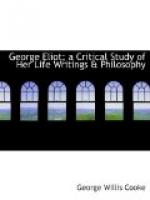“Ten years after this, in 1859, as the distinguished portrait-painter, Mr. Samuel Laurence, was returning from America, he happened to meet with ’Adam Bede,’ then just published. He was so delighted with the book that he was determined to know the author, and it was revealed to him that to do so he had but to renew his old acquaintance with Mr. George Henry Lewes, whom he had met years before at Leigh Hunt’s. He made George Eliot’s acquaintance, and was charmed with her, and before long he asked leave to make a study of her head. She assented without any affectation, and, in the early months of 1861, Mr. Lewes commissioned the painter to make a drawing of her. She gave him repeated sittings in his studio at 6 Wells Street, London, and Mr. Laurence looks back with great pleasure on the long conversations that those occasions gave him with his vivacious sitter. The drawing was taken front face, with the hair uncovered, worn in the fashion then prevalent, and it was made in chalks. While it was proceeding, Mr. Laurence asked her if he might exhibit it, when finished, at the Royal Academy, and she at once consented. But when the time for sending in drew near, the artist received a letter from Mr. Lewes absolutely withholding this consent, and a certain strain, of which this was the first symptom, began to embarrass the relations of the two gentlemen, until Mr. Lewes finally refused to take the drawing at all. But before the summer was out, Mr. Langford, the reader of Messrs. Blackwood of Edinburgh, who published George Eliot’s works, called on Mr. Laurence, and asked if he would consent to make a copy of the drawing for the firm. The artist replied that he should be happy to sell them the original, and accordingly it passed from his studio, in June, 1861, into the back parlor of Mr. Blackwood’s shop, where it now hangs. Like that of M. Durade, Mr. Laurence’s portrait of George Eliot is not to be in any way reproduced.
“The remaining portrait is that which we reproduce with this number. It is an elaborate chalk drawing, in black and white, with a slight touch of color in the eyes, and was executed in the latter part of 1868 and the early part of 1867, by Mr. Frederick W. Burton, at that time member of the Society of Painters in Watercolors, and now director of the National Gallery in London. George Eliot gave Mr. Burton many sittings in his studio at Kensington, and the picture was eventually exhibited in the Royal Academy, in 1867, as No. 735, ‘The Author of “Adam Bede."’ It passed into Mr. Lewes’s possession, was retained at his death by George Eliot, and is now the property of Mr. J.W. Cross. In the spring of this year, Mr. Cross came to the conclusion that—as the shop windows were likely to become filled with spurious and hideous ‘portraits’ of George Eliot—it was necessary to overcome the dislike felt by the family of the great novelist to any publication of her features, to which in life she had been averse, and he thereupon determined to record




